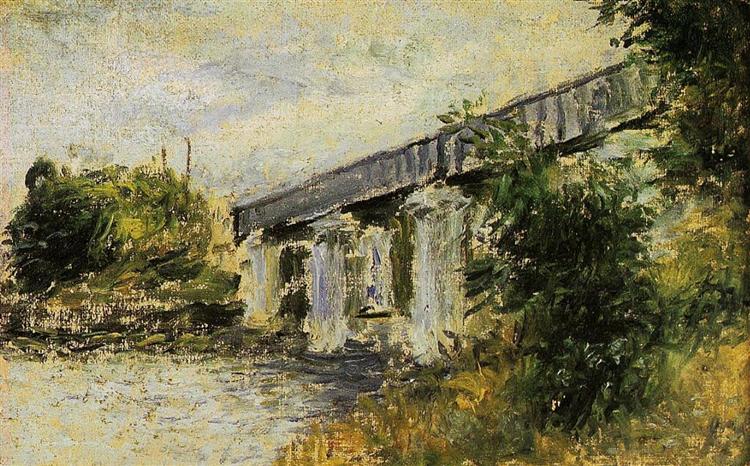תיאור
In 1874, Claude Monet, one of the founders of Impressionism, presents his work “Railway Bridge at Argenteuil”, which not only captures a specific moment in time, but also encapsulates the spirit of an era dominated by industrialization and change. This painting, one of his masterpieces, reflects the landscape of Argenteuil, a town on the banks of the Seine that became a recurring place of inspiration for the artist, symbolizing both natural beauty and the intrusion of progress.
The composition of the work is notable for its balanced structure that guides the viewer’s gaze. The railway bridge, which extends into the horizon, acts as a diagonal element that fragments the canvas, creating a dynamic environment. This effective use of lines guides the attention to the details of the railway and, at the same time, establishes a dialogue between the vegetation in the foreground and the wide sky beyond. To the left of the work, a vibrant green landscape opens up, where trees and lush flora can be seen, contrasting with the grey structure of the bridge, evoking the coexistence of the industrial and the natural.
The use of color in this piece is characteristically Impressionist; Monet applies his palette with loose, fluid brushstrokes that allow the colors to blend together in an almost optical manner. The blue hues of the sky are reflected in the surface of the water, while the greenery of the vegetation suggests a luminosity that resonates in every section of the painting. The atmosphere of the painting is predominantly daytime, with vibrant lights making the scene pulsate, a distinctive element of Monet's style.
Interestingly, Railway Bridge at Argenteuil is set in a period when Monet and his contemporaries were beginning to challenge academic norms of art, seeking to capture the fleeting essence of light and movement. Although the work appears to depict an idyllic landscape, it is, in essence, a commentary on the transformation of the environment through modernity. Although there are no major human figures in the scene, the mere presence of the railway bridge suggests the activity of a world in motion, perhaps hinting at the arrival of new eras of communication and movement.
When looking at this work, it is interesting to note how Monet reproduces one of the classic themes of French painting: the interaction between the natural and the artificial, a concept that resonates in other works of his time, such as “The Water Lily Pond” or “Impression, Sunrise”. The essence of Impressionism lies in this exploration of light, colour and the everyday landscape, where nature provides a backdrop for growing human activities.
In short, “Railway Bridge at Argenteuil” is more than just a painting; it is a prism through which we can understand Monet’s view of the social and environmental change of his time. The work not only celebrates the beauty of the French landscape, but also raises questions about the harmonious coexistence (or lack thereof) between man and his environment, thereby capturing a crucial moment in the history of art and contemporary life in the 19th century. In this sense, Monet stands as a visual historian of his time, fostering an enduring reflection on the relationship between nature, industry and artistic perception.
KUADROS ©, a famous painting on your wall.
Hand-made oil painting reproductions, with the quality of professional artists and the distinctive seal of KUADROS ©.
Painting reproduction service with satisfaction guarantee. If you are not completely satisfied with the replica of your painting, we will refund 100% of your money.

